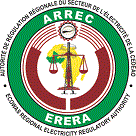The Republic of Ghana has constructed the first micro-hydro power project on Tsatsadu River in Alavanyo-Abehenease in the Hohoe Municipality in the Volta Region of the West African country.
The project, which is in two phases with the first phase due for commissioning by President Akufo-Addo, has a turbine with 45 kilowatts’ capacity.
The second turbine, which has a capacity of 65kilowatts, is expected to be fixed later.
The project, which was constructed by the Bui Power Authority (BPA) at the cost of US$400,000, from its internally generated funds, is expected to provide electricity to the people of Alavanyo-Abehenease and the surrounding villages.
Power from the Tsatsadu Generation Station will be fed into the national electricity grid, but one interesting aspect of the project is that even when there is power interruption from the Akosombo Dam, the people of Alavanyo-Abehenease and surrounding communities would still have electricity.
Background
Ghana’s Ministry of Energy, in 2005 entered, into a Memorandum of Understanding (MoU) with the United Nations Development Organisation (UNIDO) and International Network on Small Hydro-Power (INSHP) to undertake studies to develop small hydro power potentials in the country.

Tsatsadu Waterfalls, located in Alavanyo-Abehenese in the Hohoe Municipality of the Volta Region, was selected to be developed as a pilot project.
UNIDO, subsequently, donated a 45kW capacity Turgo Turbine and associated electromechanical equipment for the project.
Unfortunately, the Volta River Authority, which energynewsafrica.com understands, was given authorisation to execute the project, faced some challenges and hence its inability to commence the execution of the project.
The Ministry of Energy, in 2016, then appointed the Bui Power Authority to develop the Tsatsadu Mini Hydro project on its behalf.
BPA, then, reviewed all available information on the project by undertaking several feasibility studies of the site, conducting detailed topographical surveys and completed designed drawings for the civil structures. It also undertook retrofitting activities on the turbines. BPA, furthermore, constituted a technical committee to implement the project.
BPA, furthermore, constituted a technical committee to implement the project.
The committee comprised representatives of the Renewable and Alternate Energy Directorate of the ministry of Energy, the Energy Commission, the UNDP-RETT project implementation unit, SAS Finance group and Electricity Company of Ghana (ECG).
Project Descriptions
The Tsatsadu Hydropower is a run-of-the-river scheme with no impoundment. It consists of a concrete diversion weir, an intake structure, diversion channel, a fall bay, steel penstock, a power house (to house turbines and the generator) and a transmission line to tie the line to the distribution grid.
The headworks and powerhouse are situated on the right bank of the river. The 8m-long concrete weir diverts part of the river flow (toward the edge of the cliff) through an intake channel into the diversion channel. The diverted water is then transported through the diversion channel into a forebay tank.
The water then goes through a 300mm-diameter penstock to the base of the hill where the power house is located. The water drives the turbine and escapes through the tail rays channel and finally discharges back into the downstream of the waterfall.
Chief Executive Officer of Bui Power Authority, Fred Oware explained in an interview with energynewsafrica.com that upon assumption of office and seeing the initial feasibility studies in 2017, “I went to the then Minister, Mr Boakye Agyarko, and indicated to him that we have engineers who can work to bring the project into fruition.”

According to him, Boakye Agyarko gave him a letter of approval and, therefore, took the necessary steps to ensure that the project was actualised.
Engineering Work
Fred Oware explained that the project was fully executed by engineers from Bui Power Authority without expatriates.
Mr Oware, who touted the competencies of engineers at Bui Power Authority, noted that the cost of the project would have been higher if expatriates were involved.
He urged Ghanaians to have faith in local engineers, stating that “it is only in Ghana where local engineers have constructed hydropower. You cannot find it anywhere in Africa.”
He said per the work which the engineers had done, they are capable of doing other projects. Based on this, he called on the government to give the BPA the necessary push in order to undertake similar projects in other parts of the country.
“Our engineers are very competent. They have the expertise to deliver because they were trained by Chinese. Let’s put them to work and not let them sit idle,” he said.
Appeal
Mr Oware called on the government, through the Ministry of Energy, to give Bui Power Authority the necessary push for it to develop other waterfalls into hydropower project.
“When we send proposals, they should give us the approval,” he said.
Mr Oware explained that he desires that BPA would, one day, become like the VRA.
Source: www.energynewsafrica.com
















